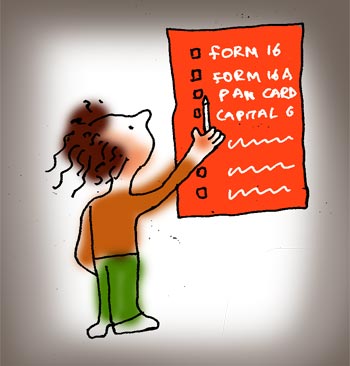
It's that time of the year again when many of us find ourselves in a mad rush to make our investments and get our paperwork in order. As tax filing season rolls around, it's not uncommon to feel totally lost about the taxes you need to pay to the government and the documents you need. So to help you make sense of your taxes, Investmentyogi.com shares some pointers...
Given in the table alongside are the income tax slab rates for FY 2009-10 (corresponding to Assessment Year 2010-2011).
Let's take an example to clearly understand the tax calculation. Vikky, 30, is a marketing manager employed at XYZ with taxable income of Rs 9,90,000. As per the tax slab, his tax liability (including education cess of 3 per cent) would come to Rs 2,07,030 for FY 09-10.
Instead of paying such high amounts in tax, one can claim various deductions under Chapter VI A and reduce the net taxable amount. This way one can invest as per his/her financial goals and save on taxes too.
Let's continue the same example to see how much can be saved in taxes by investing in tax saving instruments under Chapter VIA.
...

Let's assume Vikky had bought a mediclaim insurance policy in FY 2009-10 (insurance premium Rs 10,000 pa). He has also invested in PPF for Rs 40,000, term life insurance policy (insurance premium Rs 25,000; annual), ULIP (premium Rs 26,000; annual), tax saving mutual fund (amount invested in FY 2009-10 is Rs 50,000), pension plan of mutual fund PQR (contribution for FY 2009-10 is Rs 25,000).
From the above, you can see that Vikky has invested a total of Rs 1,66,000 in various tax saving products for FY 2009-10 apart from the contribution to mediclaim insurance policy. As per the tax slabs for FY 2009-10, he can claim a maximum of Rs 1 lakh tax deduction with Sec 80C, Sec 80CCC (contribution to pension funds) put together and up to Rs 15,000 pa for payment towards medical insurance premium paid towards policy for self.
Therefore, under Sec 80C and Sec 80CCC he gets a deduction of Rs 1 lakh and under Sec 80D he gets a deduction of Rs 10,000. Claiming the total tax deduction of Rs 1,10,000, his net taxable income reduces to Rs 8,80,000. Hence, his tax liability is reduced to Rs 1,73,040; a saving of Rs 33,990, which can be directed towards other investments/ financial commitments.
This is a simple example of saving taxes through investments in government-approved schemes.
Note: Surcharge of 10 per cent on income tax is not applicable from FY 2009-10.
Click NEXT for the list of documents you will need...

Given below is a list of some of the essential documents you will require when filing you taxes:
Documents for salaried individuals with/without interest income
Documents for house property income:
Income from capital gains:
Income from business/profession:
Illustration: Dominic Xavier